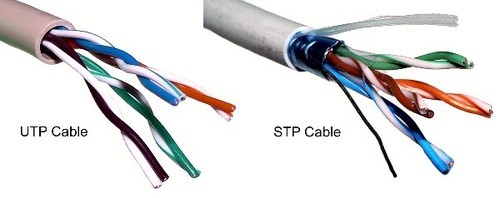Twisted Pair Cable
Twisted Pair Cable
A twisted pair consists of two conductors (normally copper), each with its own plastic insulation, twisted together, One of the wires is used to carry signals to the receiver, and the other is used only as a ground reference. The receiver uses the difference between the two.
• A twisted pair consists of two insulated copper wires, typically about 1 mm thick.
• The wires are twisted together in a helical form, just like a DNA molecule.
• Twisting is done because two parallel wires constitute a fine antenna.
• When the wires are twisted, the waves from different twists cancel out, so the wire radiates less effectively.

Twisted Pair Cable
Why cable is twisted?
• If the two wires are parallel, the effect of these unwanted signals is not the same in both wires because they are at different locations relatives to the noise or crosstalk sources.
• This results in a difference at the receiver.
• By twisting the pair, a balance is maintained.
Types of Twisted-Pair Cable
1. Unshielded twisted-pair (UTP)
The most common twisted-pair cable used in communications is referred to as unshielded twisted-pair (UTP). This is the most commonly used medium today, because of its usage in the telephone system. This cable can carry both voice as well as data. It consists of two conductors (usually copper). In the beginning, the wires used to be kept parallel. However, this results in far greater levels of noise. Hence, the wires are normally twisted. This results in the reduction of noise to a great extent, although it is not eliminated completely. The copper conductors are covered by PVC. or other insulator.
UTP is flexible, cheap and easy to install. The Electronic Industries Association (EIA) has developed standards for UTP cables.
1. The basic cable used in the telephone system. This is fine for voice communication, but is unsuitable for data communication, except at very low speed.
2. Suitable for voice and data communication up to the speed of 4 Mbps.
3. Can carry voice and data up to 10 Mbps. It requires minimum three twists per foot. Today, these are more regularly used in telephone networks.
4. These are similar to the category 3, but can handle data up to 16 Mbps.
5. Can handle data speed of 100 Mbps.
2. Shielded twisted-pair (STP)
In this case, apart from the insulator, the twisted wire pair itself is covered by metal shield and finally by the plastic cover. The metal shield prevents penetration of electromagnetic noise. It also helps eliminate crosstalk, an effect wherein one wire picks up some of the signals travelling on the other wire. This effect can be felt sometimes during telephone conversations, when we hear other conversations in the background during our call. The shield prevents such unwanted sounds.
Applications :
» Used in telephone lines to provide voice and data channels.
» The DSL lines uses by telephone companies use the high-bandwidth capability of UTP cables.
» LANs, such as 10Base-T, 100Base-T also uses twisted-pair cables.
